Last in a series
TULALIP – For participants in the Tulalip Tribes’ Healing to Wellness Court, the path to substance abuse recovery is long, but having family support through the months-long program can make the journey smoother.
“I have a strong bond with my grandmother,” said Summerlee Blankenship, a Wellness Court participant who joined the first group of participants in January. “Others don’t necessarily have the support.”
Wellness Court encourages family and others to come to court and get directly involved. A goal is to reunite families, but that can sometimes be difficult.
Court coordinator Hilary Sotomish said, “A lot of other people have burned too many bridges so they don’t have family,” adding a layer of difficulty to recovery efforts.
Tribal Judge Ron Whitener said too often when someone becomes an addict, their social family is other addicts rather than real family. Wellness court seeks to reunify real families.
That’s a critical component to helping participants achieve, Tribes Prosecutor Brian Kilgore said. Within the tribes, a shared culture, beliefs and values exist with defendants sharing much more in common.
“Most live here and grew up here with their parents and grandparents,” Kilgore said. “When you’re a smaller community, you have a shared cultural heritage. That is a tremendous tool.”
Whitener said one of the biggest changes in being judge-like is you really want to build a rapport with participants. “You reward the things that they’re doing right. Little things. You want to point out the good things that they did.”
Kilgore agreed. “At least with gift cards and positive reinforcement from one week to the next, the drugs don’t win every time.”
Hearing applause for the participants never gets old.
“When you see the effect on the human being, it’s profound,” Kilgore said. “It changes their behavior. Often, it’s applause, appreciation and respect in their life outside Wellness Court they’re not getting that from the people that matter.”
Kilgore said the threat of jail time isn’t the deterrent that stops a person from committing a crime. More often, he said, it’s a voice of conscience saying, “’What would my grandmother think?’ That’s the factor that stops someone from naturally stealing. Not the fear of jail as punishment.
“At the end of the day, this is a court program for anyone who is ready to make a change in their life and wants to address the reasons they’re sitting in that orange jumper,” Kilgore said. “If they’re not ready to make a change, this program is not for them.”
The tribal cultural setting is what makes a wellness court unique from a drug court.
“A big tribe but it’s a small group. You have all these ties between people and participants. That’s really unique for a tribe. And you have all these other cultural things – a reflected of the values, history and community. Within that social network are opportunity to use those things to help rebuild their relationship with the community,” Whitener said.
He added that after two years hopefully the participants will have built a foundation where they can go out on their own.
That’s Blankenship’s hope. “I definitely think it’s going to save lots of lives
and help so many generations,” he said. “I’m just so grateful for this program.”
Blankenship said she wants to go to school, become a certified personal trainer and take things one step further. “I want to work in chemical dependency, not so much as a counselor but to work with kids who struggle,” she said.
Blankenship is in a unique position because she previously graduated from the county’s drug court. She said the coordinators talked about growing a mentor program for juvenile drug court. That’s a program that would appeal to her wanting to give back.
The Wellness Court is making a believer out of Robert “Whaa-Ka-Dup” Monger, a team member and recovery coach with the Healing Lodge, who also oversees the Sweat Lodge and spiritual ceremonies.
“At the beginning, I was not happy about the Healing to Wellness Court,” he said. “I thought they were going to be treating them with kid gloves. That’s not the way I grew up learning.”
He works one on one with lodge residents and wellness participants, teaching them skills and driving them to appointments. Monger shares the knowledge and experience he has gained during a life that included jail time and brushes with the law, but has since grown into giving back to the community amid 22 years and 10 months of sobriety, he said.
For Wellness Court participants, he tells them it may feel like “you’re sliding down a mountain.”
“I know these kids. I remind them that when they’re looking at jail time, and they’re offered this court program. They need to take it. When you’re all done, all your baggage stuff goes away,” Monger said.
Like others on the Wellness Court team, Monger stands up to help young people get into workforce training and the construction trades through the Tulalip Tribal Employment Rights Office, or TERO.
To graduate, participants must complete five stages of wellness court, Sotomish said. The first two stages are centered around stabilization and accountability, generally the initial weeks of getting to know the ropes of the system. Stage 3 builds life skills, education and job training planning and completion into the regimen. Stage 4 begins the work on community give-back hours. The final stage ties together all aspects of the program.
Participants receive a decorative Native American lapel pin that symbolizes their completion at each stage. Most participants are now are at Stage 2.
“If they follow the program to a ‘T’ everything can be done in fifteen months,” Sotomish said.








